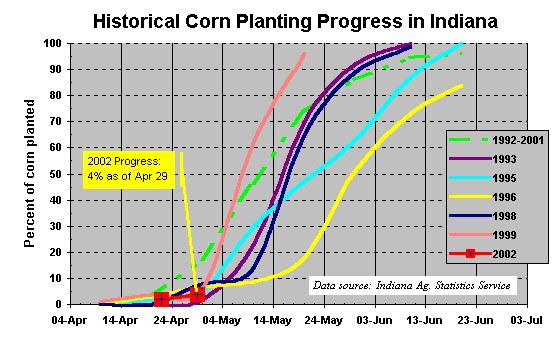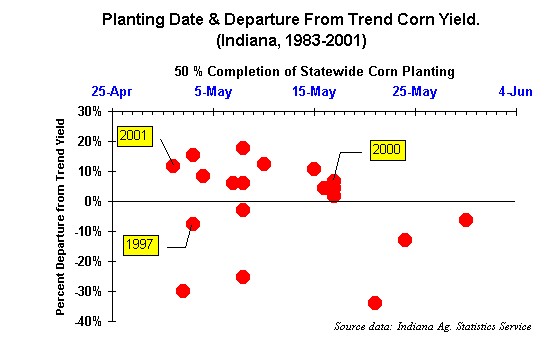

![]() onventional wisdom says that the prime planting window
for achieving optimum corn yields in much of Indiana opens about April 20 and
closes about May 10. This 'window' opens about one week later across the
northern tier of counties and about one week earlier across the southern tier
of counties. According to the
Indiana Agricultural
Statistics Service, only four percent of the state’s corn crop was
planted as of April 28. That pace puts us in an unenviable dead heat with five
of the slowest corn planting years out of the last ten. That leaves a lot of
corn to be planted between now and the 10th day of May before that
prime planting window closes.
onventional wisdom says that the prime planting window
for achieving optimum corn yields in much of Indiana opens about April 20 and
closes about May 10. This 'window' opens about one week later across the
northern tier of counties and about one week earlier across the southern tier
of counties. According to the
Indiana Agricultural
Statistics Service, only four percent of the state’s corn crop was
planted as of April 28. That pace puts us in an unenviable dead heat with five
of the slowest corn planting years out of the last ten. That leaves a lot of
corn to be planted between now and the 10th day of May before that
prime planting window closes.

What are the consequences of planting corn after May 10? How important is planting date as a predictor of statewide corn yield anyway? Does late planting in and of itself guarantee lower than normal yields? Interestingly enough, the planting date effect on yield is somewhat paradoxical.
If one reviews the data for average statewide planting dates and corn yield for the past nineteen years, there is NOT a strong relationship between the date by which half of the state's corn is planted and the consequent statewide average corn grain yield. In fact, less than 10 % of the variability in statewide corn grain yield during the past nineteen years is related to planting date.

So what's the deal? Why do agronomists preach about the importance of timely planting and yet the statewide statistical data do not appear to substantiate this importance? Let me try to explain.
The bad news is that corn grain yield potential does indeed decline by one to two bushels per acre per day of delayed planting after about May 10. That means, for example, that corn planted on May 30 would be expected to yield from 20 to 40 bushels less than corn planted before May 10. Delayed planting beyond early May will typically result in lower corn yields because of a number of factors, including a shorter growing season, insect & disease pressure, and moisture stress during pollination.
The good news is that planting date is but one of many yield influencing factors (YIFs) for corn. All of the other YIFs interact with planting date to determine the overall yield potential for any given year. In other words, although we know that early-planted corn will usually yield more than later-planted corn, the exact or absolute yield level is dependent on a host of other YIFs. Therefore, it is possible for early-planted corn in one year to yield more than, less than, or equal to later-planted corn in another year depending on the exact mix of YIFs for each year. That is the reason why statewide average corn grain yields frequently vary by plus or minus 10% from the expected trend yield from year to year.
For example, the crop years 1997 and 2000 represent early and late planting dates in Indiana. The date by which half of the state's corn crop was planted in 1997 and 2000 was May 3 and May 17, respectively. Yet, the earlier planted 1997 crop yielded 7.5% BELOW trend yield for that year and the later planted 2000 crop yielded 6.6% ABOVE trend yield (Fig. 2) according to the Indiana Agricultural Statistics Service.
Bottom Line: Don't carried away about the influence of planting date on total corn production. While important, planting date is only one of many yield-influencing factors for corn.
 For other
information about corn, take a look at the Corn Growers Guidebook on the World
Wide Web at http://www.kingcorn.org
For other
information about corn, take a look at the Corn Growers Guidebook on the World
Wide Web at http://www.kingcorn.org